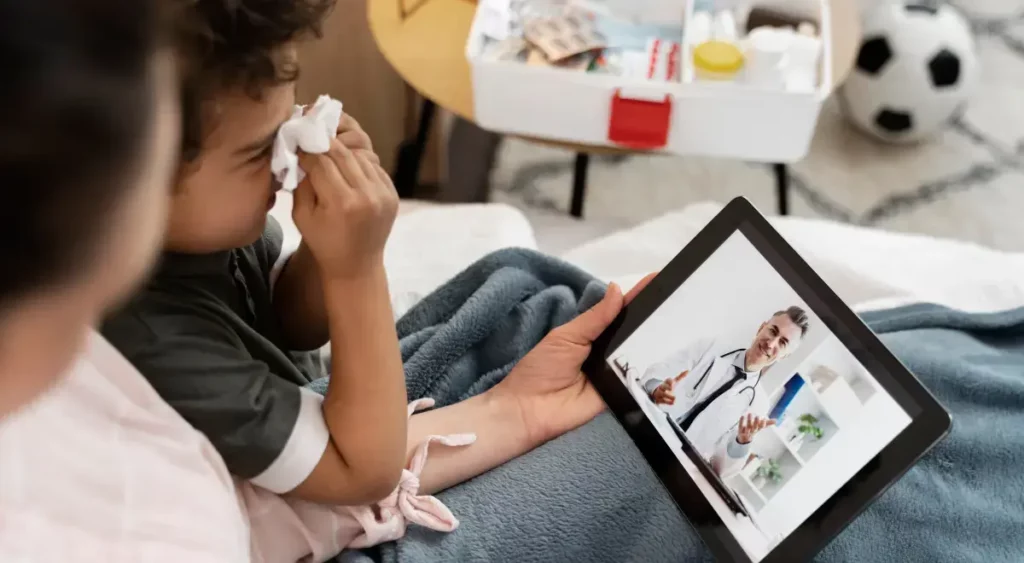Addressing Gaps in Remote Care With Virtual Care Management

At every stage of a patient’s wellness journey, there’s a need to promote and facilitate a proactive approach to healthcare, both for patients and medical practitioners. The answer to this proactive healthcare necessity is Remote Care.
Remote care is the delivery of healthcare services outside of traditional clinical settings, usually via virtual communication and the use of remote technology, such as remote patient monitoring, mobile health, and telemedicine.
Table of Contents
ToggleHow Virtual Care Management Helps Address Care Gaps
Virtual care management provides valuable insights into patient decision making and preferences. Not only this, it provides a deeper grasp of optimizing treatment both in and out of the doctor’s office for efficient provider operations and better patient outcomes.
One of the most significant advantages of a virtual care management system is that it saves time and money, which both clinicians and patients could benefit from. More time for clinicians to ensure they can look at and treat their patients. More time for patients to take control of their care, which in turn ensures excellent health.
Virtual care management enables physicians to extend their care services outside of their practice, keeping track of their patients’ well-being outside of the conventional 15-minute consultation.
Some ways in which virtual care helps improve healthcare and care coordination include:
- Enhances Care Management
The foremost benefit virtual care or digital health platforms offer is improving care management among patients. Chronic care management (CCM) is a great platform for virtual care management. It monitors and manages chronic health issues by integrating directly and seamlessly into healthcare provider organizations’ electronic health records (EHR) systems. This ensures consistent monitoring of patients with chronic health conditions while improving operational efficiency and care management. Some ways by which CCM improves virtual care management include:
- Automated care planning
- Day-to-day time documentation
- Medicare program compliance
- Financial tracking and reporting
- CCM billing support
- Improves Health Monitoring
Virtual care management plays a critical role in addressing the mental and physical care gaps by providing effective health monitoring for chronic and behavioral health conditions. With fewer impediments to care, clinicians can enhance their availability and improve patient response time, along with offering:
- Improved healthcare monitoring visibility
- Early intervention to prevent health deterioration
- Enhancing medication management
- Effective monitoring of progress
- Increased Access to Remote Care
Remote care can considerably improve access to healthcare services, especially for those living in rural or remote locations by connecting patients to healthcare providers who may not be physically present in their location. Also, remote care allows healthcare providers to monitor patients with chronic diseases, allowing for early intervention and avoiding costly hospitalizations. Not only this, physicians can help engage and educate their patients, thereby allowing them to take an active role in their own care.
- Improved Care Coordination
Remote care can help healthcare providers and patients communicate more effectively, resulting in better care coordination. Remote monitoring allows healthcare providers to track a patient’s health status over time, resulting in better decision-making and care planning.
- Better Patient Outcomes
Remote care can improve patient outcomes by giving patients faster and more convenient access to healthcare services. Remote monitoring can help patients better manage chronic illnesses, lowering the risk of complications and hospitalizations, along with engaging them to take a proactive role in maintaining their health.
- Reduced Healthcare Costs
Remote care can reduce healthcare costs by preventing costly hospitalizations and emergency visits. RPM with predictive analysis can help healthcare providers identify potential health problems early, allowing for early intervention and preventing the need for hospitalization. Digital health platforms can support patient self-management, reducing the need for costly interventions.
Conclusion
Virtual care management with remote care delivers effective results when it adapts to and complements the current healthcare scenario and workflows at healthcare practices.
HealthArc is proudly assisting both patients and healthcare providers in ensuring complete care coordination by synchronizing the patient data with clinicians on its digital health dashboard. We know that there is no one-size-fits-all solution when it comes to healthcare, and that’s why we keep updating our systems to cover any gaps in healthcare.
We enable healthcare providers to maximize their patient management outside clinical settings with a highly engaging technology solution that delivers:
- Efficient Patient Management
- Seamless Health System Integration
- Reimbursement Maximization
- Tailored Solution with Zero Setup Costs
- Seamless Onboarding and Integrations
- Rapid Scaling and Best-in-Class 24/7 Support
We empower healthcare providers with the best in digital health and cellular devices so they can empower their patients. Let’s together help close the remote care gaps, optimize patient outcomes, and improve the bottom line. Schedule a demo to learn more about our remote monitoring platform or call us today at +201 885 5571 to set up a consultation with our experts.
Most recent blogs
Categories
- Behavioral Health Integration
- Cellular Remote Patient Monitoring
- Chronic Care Management
- Chronic Care Management Billing
- Chronic Care Management CPT Codes
- Chronic Care Management Program
- Chronic Care Management Software
- Digital Health Platform
- Principal Care Management
- Principal Care Management CPT Codes
- Remote Monitoring Devices
- Remote Patient Care
- Remote Patient Monitoring
- Remote Patient Monitoring Billing
- Remote Patient Monitoring CPT Codes
- Remote Patient Monitoring Devices
- Remote Patient Software
- Remote Therapeutic Monitoring
- Remote Therapeutic Monitoring Billing
- Remote Therapeutic Monitoring CPT Codes
- Telemedicine & RPM
- Transitional Care Management
- Transitional Care Management Billing
- Transitional Care Management CPT Codes
Related Posts
- February 6, 2024 | Read Time: 5 mins
CPT Code G0511 For FQHCs & RHCs
- December 25, 2023 | Read Time: 3 mins
Guide to CPT Code 99457
- December 7, 2023 | Read Time: 3 mins






